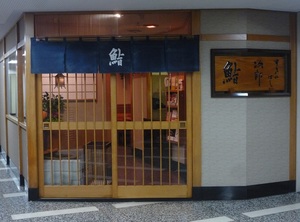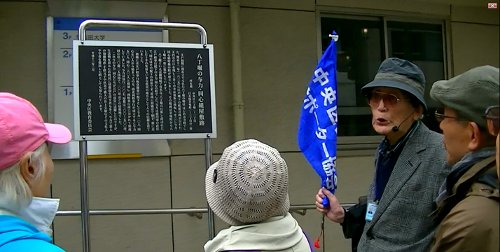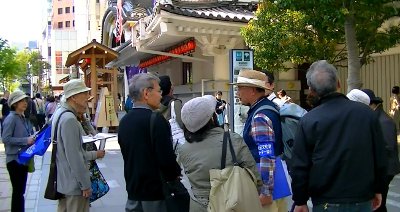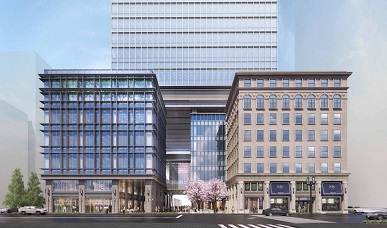Today, let's enjoy walking along the Tokaido from Nihonbashi.
Oh, before that, did you buy a souvenir in Nihonbashi?
in Nihonbashi?
Have you seen the Bank of Japan, the Currency Museum, and  the Heidai Shoran?
the Heidai Shoran?
Did you enjoy your meal at a famous restaurant?
at a famous restaurant?
Then, from Nihonbashi, the starting point of Gokaido, let's head to Shinagawa-juku through Kyobashi and Ginza.
The Tokaido is also called Ginza-dori between Chuo-dori and Kyobashi and Shimbashi while it is in Chuo-ku.
As I was talking like this, I've already come to Cored Nihonbashi.
Choledo is a coined word, and it is said that "Core of Edo", which means "center of Tokyo", was shortened to be called Coredo.
It would be nice if we had time to stop by Mr. Yamamotoyama, a long-established store that discovered Gyokuro, and Mr. Takashimaya, who was designated as an important cultural property for the first time as a department store.
In the middle of Yaesu Street, there is a "bell of peace" commemorating the declaration of peace by Chuo-ku.
http://www.city.chuo.lg.jp/heiwa/monument/kane/index.html
This bell was made in the Netherlands, and in the foreground I boarded the Dutch ship Leafde.
It is also interesting that there is a monument to Jan Jooss Ten, who drifted ashore in Bungo with British William Adams.
Jan Jooss Ten received the trust of Ieyasu Tokugawa as a consultant in trade, diplomacy, defense, etc.
He lived near Edo Castle, and the land was called Yatsushiro Sukawagi. I omit the explanation of the change of place name and place, but the place name "Yaesu" is derived from him.
By the way, we pass through Tokyo Square Garden in front of Kyobashi Senbikiya, which is famous not  only for gifts but also for fruit buffets.
only for gifts but also for fruit buffets.
On the right hand side of the Metropolitan Expressway, there is a monument to the birthplace of Edo Kabuki, the monument of Kyobashi Daikon Riverside.
Let's go around the police museum and the Kyobashi police box. All of them, such as the "Brick Ginza Monument" built by the great fire of the Meiji era, are guide monuments that give you a sense of history from the Edo era.
Let's compare the stone pillars of Kyobashi in the Taisho era with the Kyobashi police box. I admire the aesthetic sense of the person who designed the police box. Oh, the gas lamps are also lit .
.

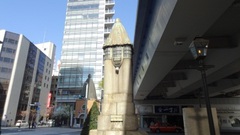
Soon after, there is a shop for Mr. Tanizawa of the bag. It is said that the kanji called bag, actually, was devised by this predecessor.
It is so famous that the word bag caught in Emperor Meiji's eyes and asked a question.
By the way, in Chinese, it seems that the bag is written as "wrapping".
In Ginza 2-chome, reading the monument of the birthplace of Ginza, the origin of Ginza is interesting.
http://www.chuo-kanko.or.jp/guide/spot/ginza/ginza_05.html
While exploring the shops introduced in the story for the first time in Chuo-ku, enjoy the Tokaido slowly with the feeling of walking around the city. On Saturdays and Sundays, please enjoy the pedestrian paradise of Ginza, which starts at noon.
Ginza 8-chome, I've already come to Brazil coffee cafe Paulista. Would you like to have a delicious coffee here and get a "Silver Bra Certificate"
cafe Paulista. Would you like to have a delicious coffee here and get a "Silver Bra Certificate" ?
?
What's missing? There are a lot of popular songs that sang Ginza. If you want to see the "Silver Koi Monument" and sing, go to the planting of Ginza Ins opposite Ginza Church.
If you want to see the "Silver Koi Monument" and sing, go to the planting of Ginza Ins opposite Ginza Church.  The lovely memories of love will be revived.
The lovely memories of love will be revived.
Then, please enjoy Shinagawa-juku and the 52nd after that. Boa viagem !
